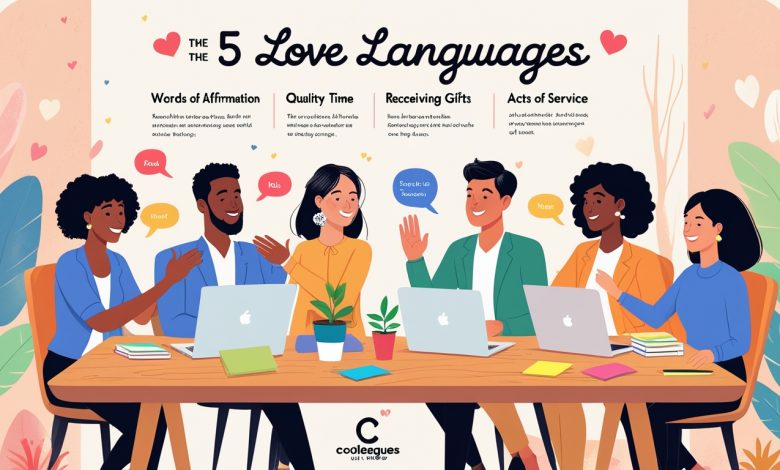Strengthening Workplace Relationships

Have you ever wondered why certain professional relationships flourish while others struggle? As a psychologist specializing in workplace dynamics, I’ve discovered that understanding personal connection preferences—what Dr. Gary Chapman originally termed “love languages”—can transform how we relate to colleagues and build stronger professional bonds.
The Psychology Behind Workplace Connections
When we adapt Chapman’s concept to professional settings, we unlock powerful tools for meaningful workplace relationships. This isn’t about bringing romance to the office—it’s about recognizing that each person has preferred ways of feeling valued and appreciated.
Research published in the Journal of Organizational Behavior confirms that employees who feel genuinely valued are 50% more likely to remain with their organization and demonstrate higher productivity levels. By understanding these different connection styles, organizations create environments where team members thrive.
Five Connection Styles for Professional Settings
Verbal Recognition: The Power of Specific Acknowledgment
People who respond to verbal recognition need more than generic praise. They flourish when their specific contributions receive thoughtful acknowledgment.
Practical applications:
- Send detailed messages highlighting particular achievements
- Recognize team members’ efforts during group discussions
- Provide constructive feedback balanced with positive reinforcement
- Write professional recommendations showcasing their unique talents
Supportive Actions: Demonstrating Reliability
For colleagues who value supportive actions, concrete help speaks volumes about your commitment to shared success.
Effective approaches:
- Assist with deadline-driven projects
- Share expertise through mentoring relationships
- Take responsibility for team tasks when needed
- Offer practical help during challenging periods
Focused Attention: Building Meaningful Connections
Some professionals feel most valued through quality interactions. Gallup research shows that employees with close workplace friendships are seven times more likely to be engaged.
Connection opportunities:
- Schedule regular one-on-one conversations
- Create collaborative thinking sessions
- Organize team activities that build relationships
- Practice attentive listening without distractions
Thoughtful Gestures: Small Tokens With Big Impact
Meaningful gestures don’t require extravagance—they simply demonstrate thoughtfulness and consideration.
Appreciation ideas:
- Share relevant professional resources
- Celebrate successful projects with team meals
- Provide growth opportunities
- Send personalized notes of appreciation
Appropriate Physical Cues: Professional Boundaries
While traditional physical touch requires careful consideration in professional contexts, alternative approaches can convey similar connection.
Professional alternatives:
- Celebrate achievements with appropriate gestures like high-fives
- Use engaged body language during conversations
- Maintain attentive eye contact
- Offer proper handshakes in formal settings
Adapting to Different Work Environments
Remote Work Settings
Creating connection across distances requires intentionality. Buffer research highlights isolation as a significant challenge for remote workers.
Distance-bridging strategies:
- Prioritize video for face-to-face interaction
- Send unexpected appreciation packages
- Create virtual celebration traditions
- Use collaboration platforms for personal connection
Traditional Office Environments
In-person settings allow for combining multiple connection approaches while maintaining professionalism.
Office-based approaches:
- Publicly acknowledge contributions during team gatherings
- Create shared experiences through group activities
- Offer immediate assistance with challenges
Hybrid Workplaces
Today’s mixed environments need balanced approaches ensuring everyone feels included regardless of location.
Hybrid strategies:
- Alternate between digital and in-person recognition
- Create inclusive team experiences
- Maintain consistent communication channels
Overcoming Common Challenges
Discovering Preferences
Challenge: How can you identify colleagues’ preferred connection styles? Solution: Pay attention to their behaviors, discuss during individual conversations, or implement anonymous team surveys.
Professional Boundaries
Challenge: Ensuring appreciation remains appropriate Solution: Always align expressions with workplace culture and organizational policies.
Cultural Awareness
Challenge: Different backgrounds may interpret gestures differently Solution: Develop cultural sensitivity and adapt your approach accordingly.
Creating a Culture of Appreciation
True transformation happens when appreciation becomes embedded in organizational practice. McKinsey research demonstrates that appreciated employees are four times more likely to engage fully with their work.
Culture-building steps:
- Develop leadership understanding of connection styles
- Gather regular feedback about team preferences
- Create celebrations for both group and individual achievements
- Foster peer appreciation systems
A Psychologist’s Perspective: Making It Work
As a psychologist, I’ve seen firsthand how these connection practices transform workplace dynamics. The key isn’t forcing artificial relationships but creating environments where everyone feels genuinely valued. Start with small, consistent efforts, and watch as your professional relationships develop new depth and meaning.
Remember—understanding these connection preferences isn’t just good psychology; it’s good business.





